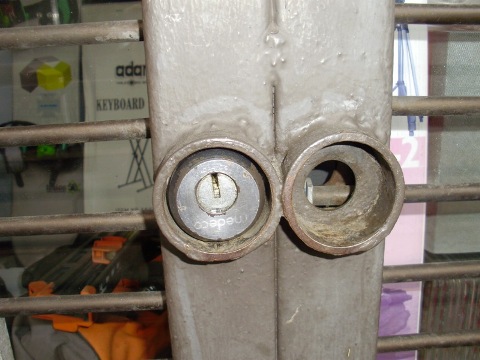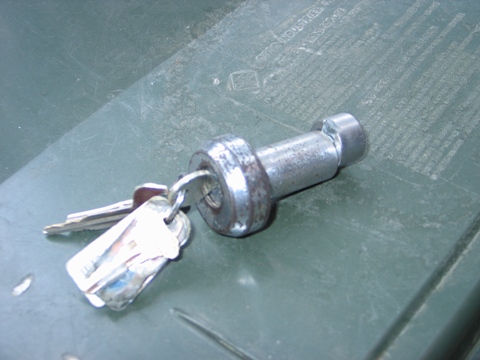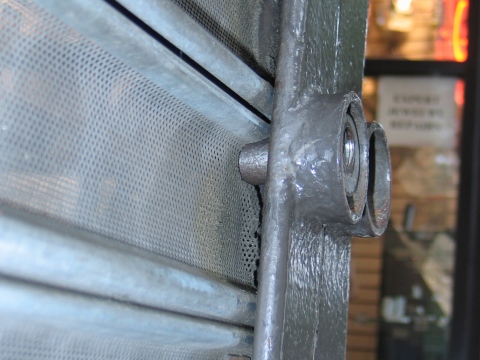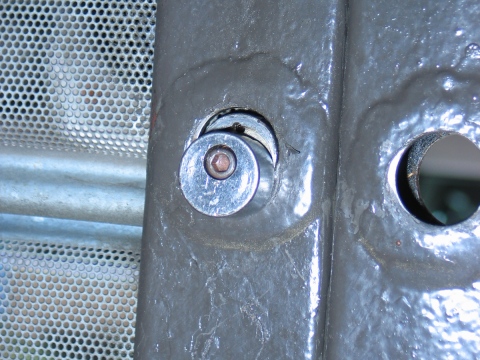
Lieutenant Brian Dalrymple from Richmond (VA) sent in these pictures of a different roll-up gate lock then we have shown here in the past. This particular lock is a pin style lock that goes through an opening in the channel and “cams†into the locked position. As you can tell from the photos below once the lock is “cammed†into place it prevents the roll-up gate from opening. There are a number of methods that would defeat this locking mechanism. Certainly, attacking the gate channel in methods shown in this previous post would work. Upon closer inspection, it was determined that those methods won;t work on this particular lock. Another option may be to attack the exposed cam by inserting the rotary saw in between the gate and the channel at a 45 degree angle.

The photo above shows what the lock looks like removed from the gate. The face of the lock is about 2†in diameter and the overall length is about 4†long. When the is gate closed, the lock is inserted through the channel, the key is then turned ½ turn. Turning the key causes the last ¾†of the lock to “cam out†thereby locking itself in place.

The photo below shows the back of the lock. You can see once the cam is is the lock position, it holds the lock mechanism in place.


This lock is called a Medeco Gate Lock, it is a very expensive ($400 to $600) and it is a very formidable lock. I disagree that a 45 degree angle cut on the gate rail will work to get this lock out. This lock has a pivoting cam on the end of the lock bolt, this bolt passes through the front and back rail that prevent this lock from being pulled out once the rail has been cut. Some methods of forcible entry that I would utilize for forcing entry into these type of locks is:
1) A Rex Tool can be used to pull the lock out of the rail, now this method would not work in gate lock shown in the photo due to a thin piece of pipe being welded onto the rail to prevent the lock being pulled. But for a lock that does not have a guard, through the lock works real nice on these.
2) A forcible entry saw can be used to plunge cut through the gate and into the back of the lock cutting the cam of the back of the bolt. This is a very reliable method and works great on locks with guards.
3) Cut the gate! If the lock can’t be forced or the gate has been distorted due to fire conditions then cutting the gate is going to be your primary attack method.
Great pictures thanks for posting.
Thanks,
Andrew
While cutting the rail may not work as mentioned, I think that the plunge cut BETWEEN the front rail and gate would work. with the bolt cut, you should just be able to pop the lock right out.
Andrew, on this lock, does the rex tool just separate the lock body fron the cam (no key tool needed)? I’m not familiar with these locks…the only Medecos common in my area are elevator controls or Knox Boxes (and they’re expensive, too).
Andrew,
You’re right that the “bending the rail outward” method will not work with this particular lock. There were a couple of other photos that I sent in that didn’t get posted. This lock has to travel through three holes before the cam is engaged. First, the hole on the front side of the channel rail, then through the gate itself and then again through the backside of the channel rail. Once through all three holes, the key is turned and the cam engaged. If cuts were made above and below the lock as in previous posts, it would be next to impossible to bend the rail outward since the lock would be anchored on the backside channel rail also.
Guys, I made the correction to the post and added the additional picture. My apologies for the misunderstanding.
Brass, your right on with those three options… In that order. Start with simplest and quickest and go from there. -Jimm-
Andrew,
Just curious about how you can expect the lock itself to react to being pulled with the Rex Tool. Are you hoping to break an internal component of the lock and have the cam shear off the back?
Sorry for my delayed response……
The Rex Tool pulls these locks out fairly effectively. Basically what happens is the bolt passes through three pieces of thin gage metal as pointed out before (the outer rail of the track, the gate, and the back rail of the track), the cam then pivots into the locking position. If you look at the 4th picture you can see that a grade 8 bolt holds the cam in place, there is very little chance of you breaking this bolt (at least I have never seen or heard of this happening). What ends up happening is that once the Rex Tool has been driven down into place and the force is applied the lock is pulled through the opening bending the rail and door on it’s way through. Is this an easy operation? no…… but you can put a little muscle into it and you can get it. The fact that this lock is so well built helps in it’s removal, the lock puller can get a real nice bit onto the lock and you don’t have to worry too much about the lock breaking during through the lock operation.
Using the saw to plunge cut between the front rail and the gate is an option, but you must be careful when performing this operation and some times because of the way the saw is set up this type of cut might be tougher than it looks. The belt drive may hinder you getting a real flush cut when cutting the left handed rail and the body and handle of the saw may impede your cut on the right handed side, this is why (in my opinion) the 45 degree angle cut is preferred. With this type of cut you have to look at how the lock and more the rail are installed, if you look at the photos that where provided the picture shows a center rail that is usually found in-between two gates on a large store front or one large section of gates over multiple stores. On these center rails that are not mounted to the wall a plunge cut would work because the back part of the lock with the cam could be pushed through the back of the gate freeing up the gate. But on gates that are mounted onto the wall there is usually not enough room to push the pin through before it hits the wall. So it is an effective method if utilized in the right circumstances but I like to stick to the 3 methods discussed in my first post.
Good posts guys! Keep them coming.
Stay Safe Brothers
Andrew
Thanks Andrew, that helps a lot. I didn’t even think about wall-mounted vs. free-standing. Definitely an interesting setup.
Hey Andrew I was going crazy trying to get one of this Locks, and before I just saw this post when I was trying to find it online.
Now I found a nice website that has this lock and they`re not that expensive ($160) comparing to the price you mentioned ($400 to $600).
I am so glad I found what I`m looking for. Thanks to your comments I feel satisfied with this lock, It works very good.
Here is the link where I bought the Medeco GateLock
http://asklocksmith247.com/medeco-gate-lock-96-0136t-26-60.html